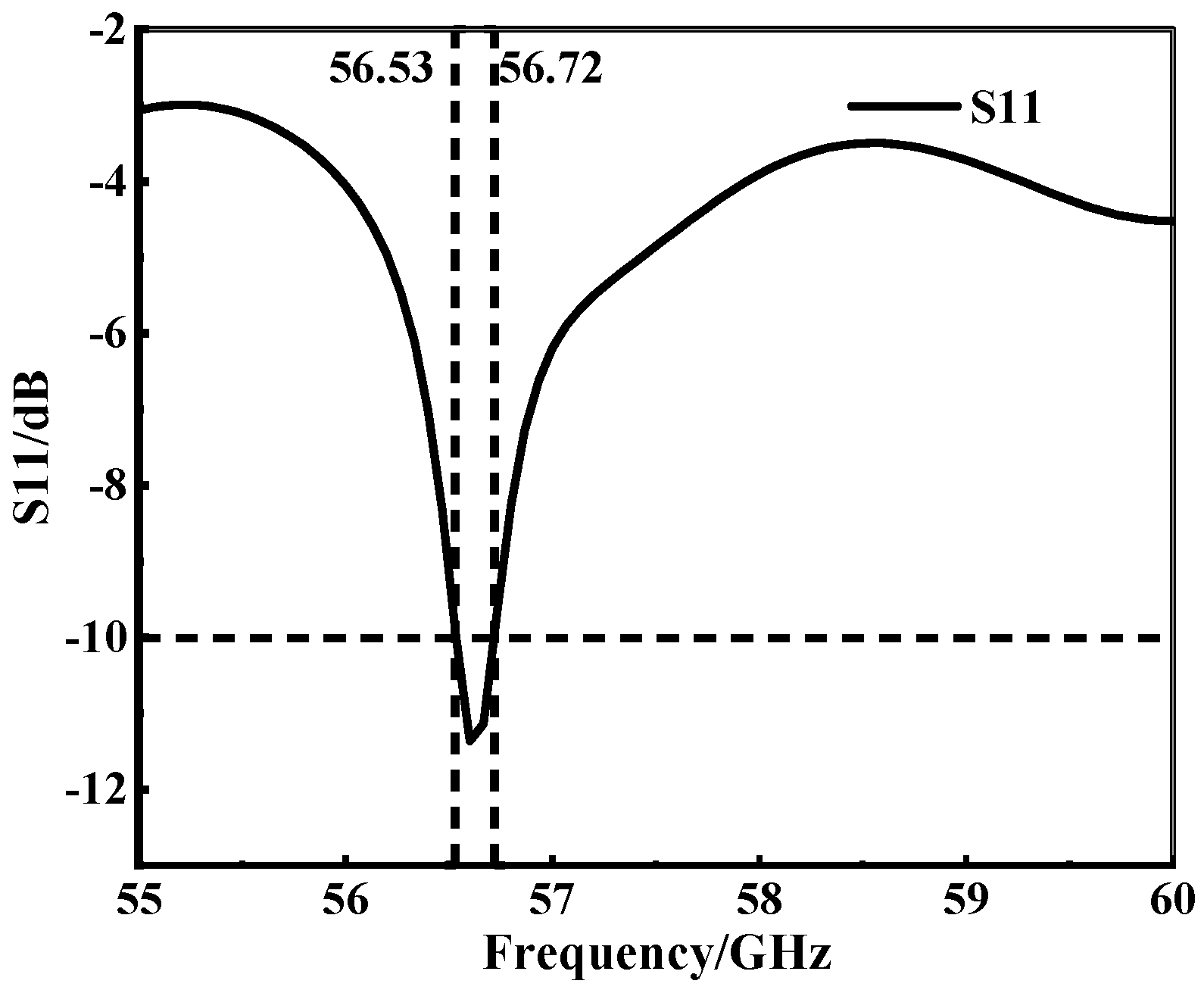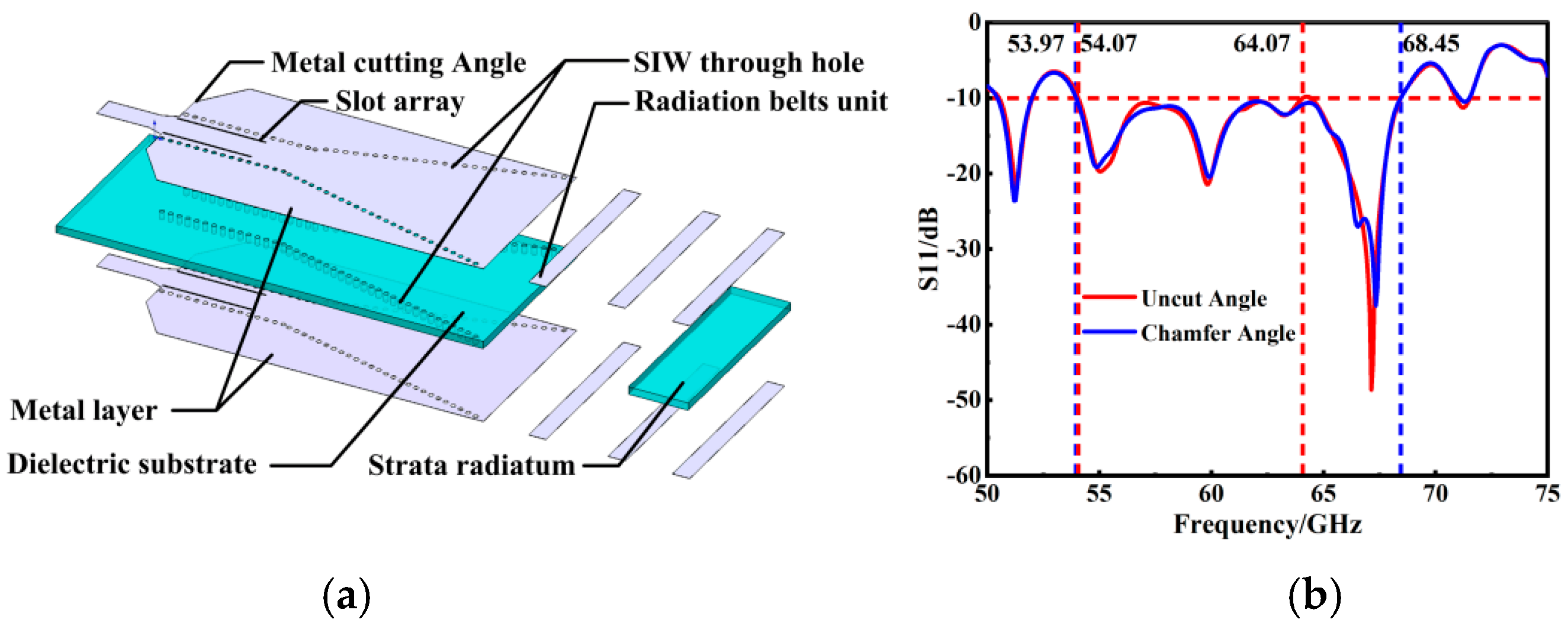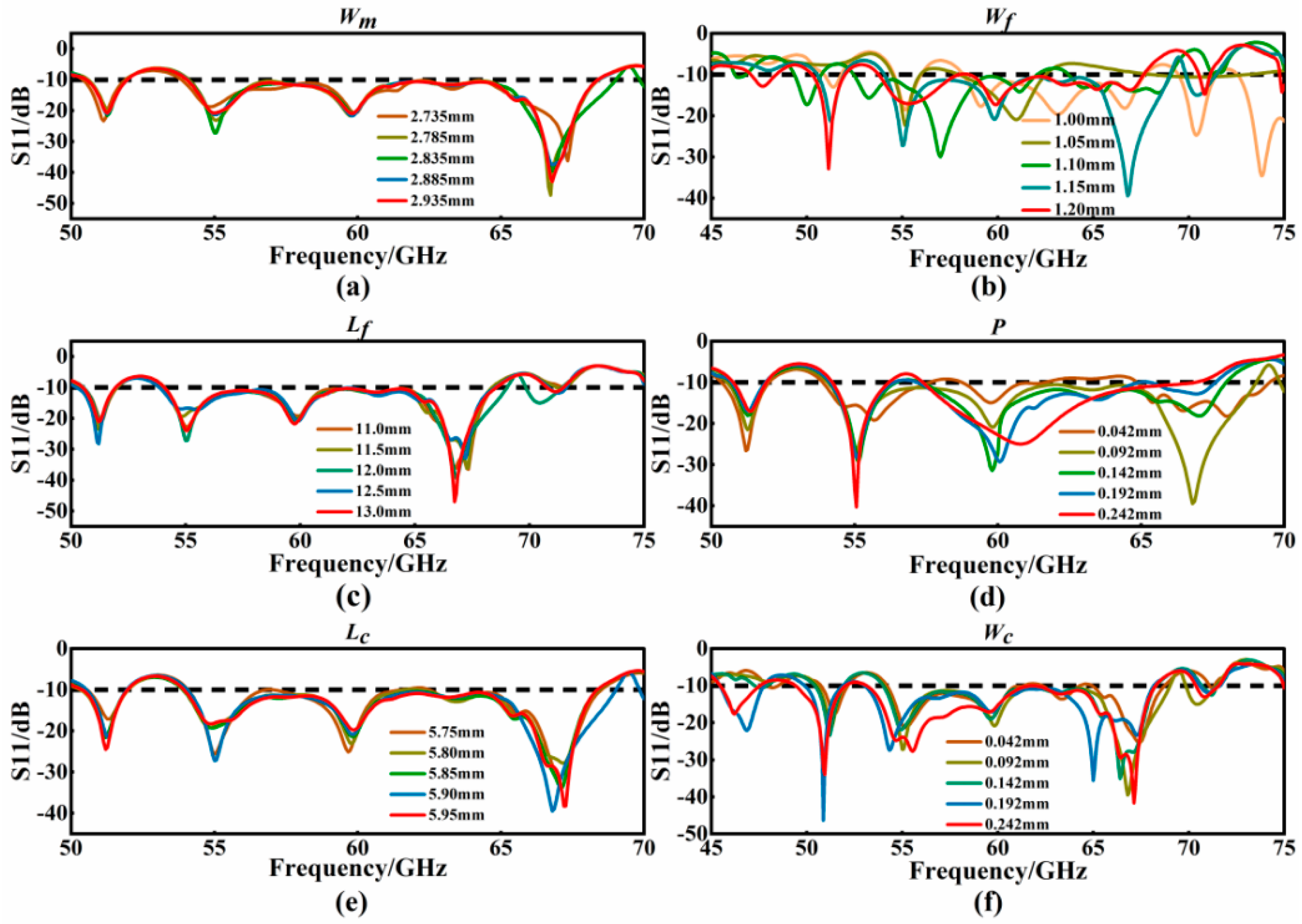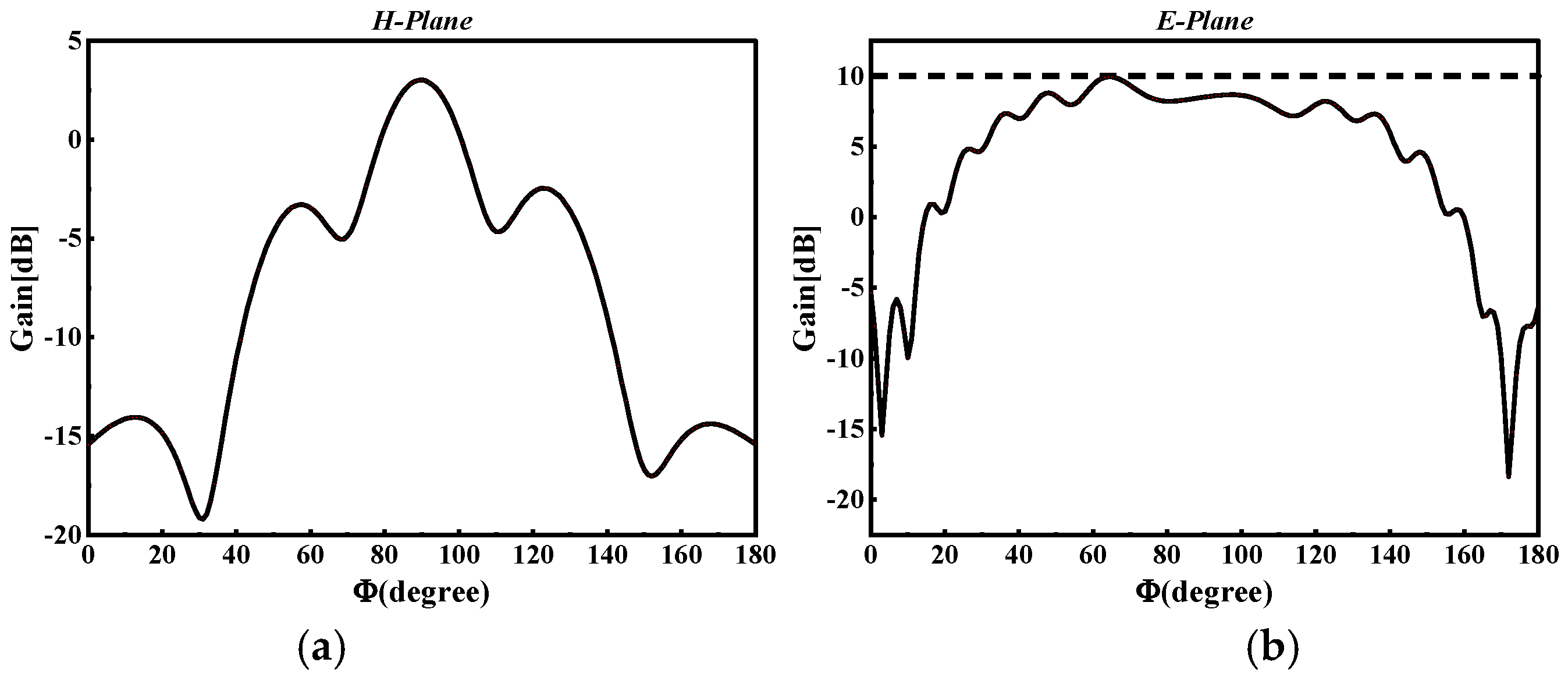A 60 GHz Slotted Array Horn Antenna for Radar Sensing Applications in Future Global Industrial Scenarios
Abstract
1. Introduction
2. Design and Simulation
2.1. SIW Structure Design
2.2. Antenna Radiation Belt Design
2.3. Antenna Slot Array
3. Analysis, Results, and Discussions
4. Comparison
5. Conclusions
Author Contributions
Funding
Data Availability Statement
Acknowledgments
Conflicts of Interest
References
- Ruan, X.; Chan, C.H. An Endfire Circularly Polarized Complementary Antenna Array for 5G Applications. IEEE Trans. Antennas Propag. 2020, 1, 266–274. [Google Scholar] [CrossRef]
- Vettikalladi, H.; Sethi, W.; Tariq, H.; Mohammed, A.M. 60 GHz beam-tilting coplanar slotted SIW antenna array. Frequenz 2022, 1–2, 29–36. [Google Scholar] [CrossRef]
- Kao, T.Y.J.; Yan, Y.; Shen, T.M.; Chen, A.Y.K.; Lin, J. Design and Analysis of a 60-GHz CMOS Doppler Micro-Radar System-in-Package for Vital-Sign and Vibration Detection. IEEE Trans. Microw. Theory Tech. 2013, 61, 1649–1659. [Google Scholar] [CrossRef]
- Shen, T.M.; Kao, T.Y.J.; Huang, T.Y.; Tu, J.; Lin, J.; Wu, R.B. Antenna Design of 60-GHz Micro-Radar System-In-Package for Noncontact Vital Sign Detection. IEEE Antennas Wirel. Propag. Lett. 2012, 11, 1702–1705. [Google Scholar] [CrossRef]
- Salarpour, M.; Farzaneh, F.; Staszewski, R.B. A low cost-low loss broadband integration of a CMOS transmitter and its antenna for mm-wave FMCW radar applications. AEU-Int. J. Electron. Commun. 2018, 95, 313. [Google Scholar] [CrossRef]
- Ye, S.; Liang, X.; Wang, W.; Jin, R.; Geng, J.; Bird, T.S.; Guo, Y.J. High-gain planar antenna arrays for mobile satellite communications. IEEE Antennas Propag. Mag. 2012, 54, 256–268. [Google Scholar]
- Li, C.; Cummings, J.; Lam, J.; Graves, E.; Wu, W. Radar remote monitoring of vital signs. IEEE Microw Mag. 2009, 1, 47–56. [Google Scholar] [CrossRef]
- Olk, A.E.; Macchi, P.E.M.; Powell, D.A. Powell, High-Efficiency Refracting Millimeter-Wave Metasurfaces. IEEE Trans. Antennas Propag. 2020, 7, 5453–5462. [Google Scholar] [CrossRef]
- Liu, D.; Gu, X.; Baks, C.W.; Valdes-Garcia, A. Antenna-in-Package Design Considerations for Ka-Band 5G Communication Applications. IEEE Trans. Antennas Propag. 2017, 12, 6372–6379. [Google Scholar] [CrossRef]
- Rabbani, M.S.; Ghafouri-Shiraz, H. Ultra-Wide Patch Antenna Array Design at 60 GHz Band for Remote Vital Sign Monitoring with Doppler Radar Principle. J Infrared Milli. Terahz. Waves. 2017, 38, 548–566. [Google Scholar] [CrossRef]
- Zhang, Z.-Y.; Zuo, S.; Zhao, Y.; Ji, L.-Y.; Fu, G. Broadband Circularly Polarized Bowtie Antenna Array Using Sequentially Rotated Technique. IEEE Access 2018, 6, 12769–12774. [Google Scholar] [CrossRef]
- Abdel-Wahab, W.M.; Safavi-Naeini, S. Wide-Bandwidth 60-GHz Aperture-Coupled Microstrip Patch Antennas (MPAs) Fed by Substrate Integrated Waveguide (SIW). IEEE Antennas Wirel. Propag. Lett. 2011, 10, 1003–1005. [Google Scholar] [CrossRef]
- Guan, D.F.; Ding, C.; Qian, Z.P.; Zhang, Y.S.; Guo, Y.J.; Gong, K. Gong, Broadband high-gain SIW cavity-backed circular-polarized array antenna. IEEE Trans. Antennas Propag. 2016, 64, 1493–1497. [Google Scholar] [CrossRef]
- Li, Y. Circularly Polarized SIW Slot LTCC Antennas at 60 GHz. In Substrate-Integrated Millimeter-Wave Antennas for Next-Generation Communication and Radar Systems; John Wiley & Sons: Hoboken, NJ, USA, 2021; pp. 177–195. [Google Scholar]
- Statnikov, K.; Sarmah, N.; Grzyb, J.; Malz, S.; Heinemann, B.; Pfeiffer, U.R. A 240 GHz circular polarized FMCW radar based on a SiGe transceiver with a lens-integrated on-chip antenna. In Proceedings of the European Radar Conference 2014, Rome, Italy, 8–10 October 2014; pp. 447–450. [Google Scholar]
- Xu, F.; Wu, K. Guided-wave and leakage characteristics of substrate integrated waveguide. IEEE Trans. Microw. Theory Tech. 2005, 53, 66–73. [Google Scholar]
- Wu, P.; Yu, Z.; Liu, K.; Zhan, F.; Wang, S.; Wang, K.; Hao, C. Low-Profile and High-Integration Phased Array Antenna Technology. In Proceedings of the IEEE Conference on Antenna Measurements and Applications (CAMA), Guangzhou, China, 14–17 December 2022; pp. 1–6. [Google Scholar]
- Chuang, H.; Kuo, H.; Lin, F.; Huang, T.; Kuo, C.; Ou, Y. 60-GHz millimeter-wave life detection system (MLDS) for noncontact human vital-signal monitoring. IEEE Sens. J. 2012, 3, 602–609. [Google Scholar] [CrossRef]
- Zhu, H.R.; Li, K.; Lu, J.G.; Mao, J.F. Millimeter-Wave Active Integrated Semielliptic CPW Slot Antenna With Ultrawideband Compensation of Ball Grid Array Interconnection. IEEE Trans. Compon. Packag. Technol. 2022, 1, 111–120. [Google Scholar] [CrossRef]
- Ramesh, S.; Rao, T.R. Indoor radio link characterization studies for millimeter wave wireless communications utilizing dielectric-loaded exponentially tapered slot antenna. J. Electromagn. Waves Appl. 2015, 29, 551–564. [Google Scholar] [CrossRef]
- Singh, A.; Rehman, S.U.; Yongchareon, S.; Chong, P.H.J. Multi-Resident Non-Contact Vital Sign Monitoring Using Radar: A Review. IEEE Sens. J. 2021, 4, 4061–4084. [Google Scholar] [CrossRef]
- Kathuria, N.; Seet, B.C. 24 GHz Flexible LCP Antenna Array for Radar-Based Noncontact Vital Sign Monitoring. In Proceedings of the Asia-Pacific Signal and Information Processing Association Annual Summit and Conference (APSIPA ASC), Auckland, New Zealand, 7–10 December 2020; pp. 1472–1476. [Google Scholar]
- Mungaru, N.K.; Shanmuganantham, T. Broad-band H-spaced head-shaped slot with SIW-based antenna for 60 GHz wireless communication applications. Microw. Opt. Technol. Lett. 2019, 61, 1911–1916. [Google Scholar] [CrossRef]
- Mungaru, N.K.; Shanmuganantham, T. Substrate-integrated waveguide-based slot antenna for 60 GHz wireless applications. Microw. Opt. Technol. Lett. 2019, 8, 1945–1951. [Google Scholar] [CrossRef]
- Shanmuganantham, T.; Kumar, K.B.; Kumar, S.A. Analysis of Tree-Shaped Slotted Impedance Matching Antenna for 60 GHz Femtocell Applications; The Korean Institute of Communications and Information Sciences (KICS): Seoul, Republic of Korean, 2021; pp. 426–431. [Google Scholar]
- Manish, S.; Ashwni, K. Conformal ultra-compact narrowband 60.0 GHz four-port millimeter wave MIMO antenna for wearable short-range 5G application. Wirel. Netw. 2024, 6, 1572–8196. [Google Scholar]
- Tsai, C.C.; Cheng, Y.S.; Huang, T.Y.; Hsu, Y.P.A.; Wu, R.B. Design of microstrip-to-microstrip via transition in multilayered LTCC for frequencies up to 67 GHz. IEEE Trans. Compon. Packag. Manuf. Technol. 2011, 4, 595–601. [Google Scholar] [CrossRef]
- Zhang, Z.; Cao, X.; Gao, J.; Li, S.; Han, J. Broadband SIW Cavity-Backed Slot Antenna for Endfire Applications. IEEE Antennas Wirel. Propag. Lett. 2018, 7, 1271–1275. [Google Scholar] [CrossRef]
- Hong, Y.; Bang, J.; Choi, J. Gain-enhanced 60-GHz SIW cavity-backed slot array antenna using metallic grooves. Microw. Opt. Technol. Lett. 2020, 62, 2429–2433. [Google Scholar] [CrossRef]
- Liu, P.; Pedersen, G.F.; Hong, W.; Zhang, S. Dual-Polarized Wideband Low-Sidelobe Slot Array Antenna for V-Band Wireless Communications. IEEE Trans. Antennas Propag. 2023, 8, 6667–6677. [Google Scholar] [CrossRef]
- Gouveia, C.; Loss, C.; Raida, Z.; Lacik, J.; Pinho, P.; Vieira, J. Textile Antenna Array for Bio-Radar Applications. In Proceedings of the International Microwave and Radar Conference (MIKON), Warsaw, Poland, 5–8 October 2020; pp. 315–319. [Google Scholar]
- Yang, T.; Zhao, Z.; Yang, D.; Nie, Z. A single-layer circularly polarized antenna with improved gain based on quarter-mode substrate integrated waveguide cavities array. IEEE Antennas Wirel. Propag. Lett. 2020, 19, 2388–2392. [Google Scholar] [CrossRef]
- Lin, S.K.; Lin, Y.C. A compact sequential-phase feed using uniform transmission lines for circularly polarized sequential-rotation arrays. IEEE Trans. Antennas Propag. 2011, 7, 2721–2724. [Google Scholar] [CrossRef]
- Abdelaziz, A.; Hamad, E.K.I. Design of a compact high gain microstrip patch antenna for tri-band 5G wireless communication. Frequenz 2019, 1, 45–52. [Google Scholar] [CrossRef]
- Grzyb, J.; Statnikov, K.; Sarmah, N.; Heinemann, B.; Pfeiffer, U.R. A 210–270-GHz Circularly Polarized FMCW Radar With a Single-Lens-Coupled SiGe HBT Chip. IEEE Trans. Terahertz Sci. Technol. 2016, 6, 771–783. [Google Scholar] [CrossRef]
- Zhu, Y.; Chen, K.; Tang, S.Y.; Yu, C.; Hong, W. Ultrawideband Strip-Loaded Slotted Circular Patch Antenna Array for Millimeter-Wave Applications. IEEE Antennas Wirel. Propag. Lett. 2023, 9, 2230–2234. [Google Scholar] [CrossRef]
- Zheng, B.; Shen, Z. Effect of a finite ground plane on microstrip-fed cavity-backed slot antennas. IEEE Trans. Antennas Propag. 2005, 53, 862–865. [Google Scholar] [CrossRef]
- Feng, W.; Ni, X.; Shen, R.; Wang, H.; Qian, Z.; Shi, Y. High-Gain 100 GHz Antenna Array Based on Mixed PCB and Machining Technique. IEEE Trans. Antennas Propag. 2022, 8, 7246–7251. [Google Scholar] [CrossRef]
- Chang, L.; Li, Y.; Zhang, Z.; Li, X.; Wang, S.; Feng, Z. Low-Sidelobe Air-Filled Slot Array Fabricated Using Silicon Micromachining Technology for Millimeter-Wave Application. IEEE Trans. Antennas Propag. 2017, 8, 4067–4074. [Google Scholar] [CrossRef]
- Agrawal, M.; Kumar, T.A. Wideband Circularly Polarized Antenna Using Substrate Integrated Waveguide and Truncated-Corner Patch Loaded Slot. Wirel. Pers. Commun. 2023, 131, 399–413. [Google Scholar] [CrossRef]
- Statnikov, K.; Grzyb, J.; Sarmah, N.; Heinemann, B.; Pfeiffer, U.R. A lens-coupled 210–270 GHz circularly polarized FMCW radar transceiver module in SiGe technology. In Proceedings of the European Microwave Conference (EuMC), Paris, France, 7–10 September 2015; pp. 550–553. [Google Scholar]
- Zhu, H.; Li, X.P.; Feng, W.W.; Yao, L.; Xiao, J.Y.; Wang, T.H. Surface micro-machined beam-steering antenna array for 60 GHz radios. Infrared Millim. Waves 2017, 36, 563–569. [Google Scholar]
- Mungaru, N.K.; Thangavelu, S. Broadband substrate-integrated waveguide venus-shaped slot antenna for V-band applications. Microw Opt. Technol. Lett. 2019, 61, 2342–2347. [Google Scholar] [CrossRef]










| Symbol | Value (mm) | Description |
|---|---|---|
| Wm | 2.735 | Width of metal cut corners |
| P | 0.150 | Radiation belt unit spacing |
| Wf | 1.000 | Radiation band unit width |
| Lf | 11.000 | Radiation belt unit length |
| Wc | 0.092 | Width of slot array element |
| Lc | 5.750 | Length of slot array element |
| Symbol | Value (mm) | Description |
|---|---|---|
| W | 11.800 | Antenna width |
| L1 | 6.705 | Transmission line and metal cutting length |
| L2 | 21.795 | Horn length |
| L3 | 3.980 | Radiation layer length |
| Wi | 1.575 | 50 Ω feeder width |
| Li | 3.500 | 50 Ω feeder length |
| Wt | 3.383 | Metallized through hole row wide |
| Lt | 8.405 | Rectangular waveguide length |
| Wm | 2.835 | Width of metal cut corners |
| Lm | 1.064 | Conical corner length |
| Wf | 1.150 | Radiation band unit width |
| Lf | 12.000 | Radiation belt unit length |
| d | 0.300 | Metal through hole diameter |
| S | 0.600 | Metallized through hole aperture |
| P | 0.150 | Radiation belt unit spacing |
| Wc | 0.192 | Width of slot array element |
| Lc | 5.900 | Length of slot array element |
| Wo | 13.000 | Width of horn antenna output |
| Bandwidth (GHz) | Gain (dBi) | Maximum Reflection Coefficient (dB) | |
|---|---|---|---|
| Phase 1 | 0.19 | 5.43 | −11.35 |
| Phase 2 | 9.56 | 10.56 | −56.08 |
| Phase 3 | 14.96 | 10.01 | −39.47 |
| Reference | Size (mm) | Gain (dBi) | Bandwidth (GHz) | Return Loss (dB) |
|---|---|---|---|---|
| [20] | 29.5 × 8 × 0.787 | 10 | 3.33 | −12.23 |
| [23] | 14 × 8 × 0.381 | / | 4.18 | −33.95 |
| [24] | 14 × 8.4 × 0.381 | / | 3.5 | −21.98 |
| [25] | 7 × 12 × 0.508 | 6.54 | 6.8 | −36.35 |
| [26] | 16 × 16 × 0.254 | 10.56 | 1.73 | <−50.0 |
| [42] (simulation) | 17.5 × 14.5 × 0.42 | 11.8 | 10 | / |
| [43] | 13 × 9 × 0.381 | / | 5.3 | −29.6 |
| This work | 32 × 13 × 0.543 | 10.01 | 14.5 | −37.51 |
Disclaimer/Publisher’s Note: The statements, opinions and data contained in all publications are solely those of the individual author(s) and contributor(s) and not of MDPI and/or the editor(s). MDPI and/or the editor(s) disclaim responsibility for any injury to people or property resulting from any ideas, methods, instructions or products referred to in the content. |
© 2024 by the authors. Licensee MDPI, Basel, Switzerland. This article is an open access article distributed under the terms and conditions of the Creative Commons Attribution (CC BY) license (https://creativecommons.org/licenses/by/4.0/).
Share and Cite
Ma, B.; Li, J.; Chen, Y.; Si, Y.; Gao, H.; Wu, Q.; Li, M. A 60 GHz Slotted Array Horn Antenna for Radar Sensing Applications in Future Global Industrial Scenarios. Micromachines 2024, 15, 728. https://doi.org/10.3390/mi15060728
Ma B, Li J, Chen Y, Si Y, Gao H, Wu Q, Li M. A 60 GHz Slotted Array Horn Antenna for Radar Sensing Applications in Future Global Industrial Scenarios. Micromachines. 2024; 15(6):728. https://doi.org/10.3390/mi15060728
Chicago/Turabian StyleMa, Binyi, Jing Li, Yu Chen, Yuheng Si, Hongyan Gao, Qiannan Wu, and Mengwei Li. 2024. "A 60 GHz Slotted Array Horn Antenna for Radar Sensing Applications in Future Global Industrial Scenarios" Micromachines 15, no. 6: 728. https://doi.org/10.3390/mi15060728
APA StyleMa, B., Li, J., Chen, Y., Si, Y., Gao, H., Wu, Q., & Li, M. (2024). A 60 GHz Slotted Array Horn Antenna for Radar Sensing Applications in Future Global Industrial Scenarios. Micromachines, 15(6), 728. https://doi.org/10.3390/mi15060728






